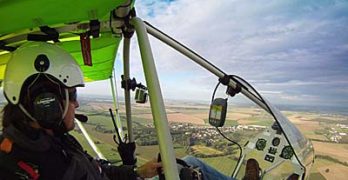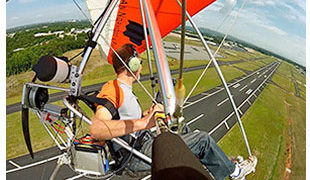Evidently, a magic number exists to authorities in various civil aviation agencies around the developed world. That magic number — more correctly a range — is 115 to 120 kilograms, or 253 to 264 pounds. FAA led this charge way back in 1982 with the introduction of FAR Part 103 codifying that an airplane, ‘er … “ultralight vehicle” with an empty weight of 254 pounds — subject to certain exceptions for emergency airframe parachutes or float equipment — could be flown without three requirements common to all other aircraft. Part 103 vehicles• do not require registration (N-numbers); the pilots of these ultralights need no pilot certificate of any kind; nor do they need a medical. Such aircraft can be sold fully built, ready to fly. The entire regulation governing their use can be printed on the front and back of a single page of paper. This simply must be one of the most remarkable deregulatory efforts in all of aviation.
Post-Oshkosh 2013 Quick Review
At the big show EAA likes to call the Summer Celebration of Flight, we rove the grounds seeking new airplanes, new engines or propulsion systems, new panel gear, updated models and more. In this very fast tour, we’ll zoom around AirVenture for a glance at some airplanes and components that caught our attention. In subsequent posts we’ll delve a bit more deeply into certain ideas we thought were novel. All photos accompanying this article are courtesy of Light Sport and Ultralight Flyer, producer of the 300+ videos you can find on this website.
Rans showed off their new S-20 Raven. Those who thought designer and company boss Randy Schlitter got stuck on S-19 were wrong (it’s never wise to think he’s done designing). His new Raven combines elements of the S-6 and S-7, namely the side-by-side seating of the S-6, with the welded spaceframe and superwide door of the S-7.
Zigolo Cracks the China Market as Part 103!
I didn’t see this one coming. Maybe you didn’t either? In the new millennia gold rush represented by companies either being bought by Chinese businesses or gaining investment from wealthy Chinese business people or by setting up shop to sell in China (or even Cessna’s ill-fated effort to have their Skycatcher manufactured in China), one element I’ve never heard of is Part 103 in China. This least-regulated-of-all aviation category is solely an American thing, isn’t it? Well … yes and no. Germany has opened the door to a Part 103-like development in that country under the 120-kilogram class (using a number that is 264 pounds or very similar to Part 103’s 254-pound empty weight limit). England has their SSDR class (SSDR being the abbreviation for Single Seat De-Regulated). Despite following those developments, I’ve never heard a word about China and any less-regulated sector.
“The first Zigolo in China was introduced to the public in that nation on July 17th at the Jingmen Airshow,” reported representative Chip W.
SkyCraft Airplanes Finishes ASTM Compliance
While so many continue to say you can’t buy a Light-Sport Aircraft for less than — pick a number … $100,000 … $150,000 — the truth is something else. We already have modestly priced entries from Quicksilver, BushCat, X-Air, M-Squared, plus several weight shift or powered parachute entries. Another that burst on the scene a couple AirVentures back was SkyCraft. The Czech design that a group in Utah are Americanizing is a fully enclosed, well-equipped single seater. Not many singles have been offered (Tecnam‘s aerobatic Snap is one such) yet the fact remain that much flying is done solo anyway, so why not have a sharp airplane for your own aerial enjoyment. Plus, what if you can fly it away for less than $60,000? Not every pilot will find SkyCraft SD-1 Minisport sufficient and lucky for those aviators, plenty of choices are available if you have to have 1,000-mile range, autopilot, big dual glass instrument panels, and of course, two seats.
Electric Trike Soars (Literally) into Record Book
On Saturday, June 21 with a good crowd watching, an electric-powered trike took off and climbed into the FAI record book, or will after the organization’s normal process is followed. Let me state right up front that this story was recently released on AOPA’s ePilot written by our journalist friend Jim Moore. Despite appearing in the big member organization’s eNewsletter, the story was too cool for me to pass up for ByDanJohnson.com plus, as usual, I have an additional perspective to offer. The images are all courtesy of record-holder-to-be, Gary Davis. If you click the link above you can read Jim’s whole article; I encourage you to do so.
As Jim wrote Gary flipped the switch and flew, “a custom combination of a North Wing Stratus trike wing matched to an electric-powered trike frame designed by Randall Fishman.” We have a number of articles and videos about Randall’s pioneering work.
HKS Four-Stroke Engine is Back on the Market
A majority of pilots express a preference for four-stroke engines due to their lower noise signature, reduced fuel consumption, ease of fueling and other reasons. For larger aircraft, engines from Rotax, Continental, and Jabiru may be preferred choices but for lighter aircraft most of these engines are more than needed (though the 80-hp Rotax 912 UL and 81-hp Jabiru 2200 can work for some intermediate-sized light aircraft). All the preceding engines are more costly as well. One popular, economical choice was the HKS from Japan but that well-regarded engine appeared destined to disappear from the American market, a shame as it is one of only a few engines to have successfully complied with the ASTM standards needed for use on LSA. No such FAA acceptance is needed for Part 103 ultralight vehicles or Experimental Amateur-Built aircraft. Fortunately, to paraphrase Mark Twain, “Reports of [the HKS] death were greatly exaggerated.”
Earlier in 2014, HKS discontinued production of HKS-700E and HKS-700T.
SkyCraft Completes Flight Testing of Minisport LSA
“After a long winter and spring dodging the Utah weather,” SkyCraft Airplanes announced that their SD-1 Minisport, “has completed flight testing successfully, meeting all the performance requirements needed for SLSA Certification.” The Orem, Utah company reported, “The plane was found to have good longitudinal and latitudinal stability and exhibited no issues with flutter, vibrations, or dangerous stall/spin tendencies.” SkyCraft representatives said they were able to verify the performance specifications for the SD-1 achieved by its Czech designers (see video below for a performance hint using a European aircraft). SkyCraft said that following the flight test regimen, they posted updated specifications on the Minisport page.
Minisport has been flying in Europe since 2007 when the airplane and company were created by designer Igor Spacek. The U.S. team first contemplated a kit aircraft — SD-1 Minisport is constructed significantly of wood making it a great project for some craftsmen — but later elected to go the fully-built Special LSA route.
Surprise Star of the Show at Aero?
It depended on whom you asked. As in the United States some were skeptical at Aero. “Oh, this will go nowhere.” “No one is interested” “We tried this and it didn’t work.” Maybe these naysayers are right, but the activity at one booth (or “stand” as they prefer in Europe) seemed to powerfully counteract that doubt. The stand was the Hirth exhibit which featured a variety of aircraft using the German powerplant. The one and only American aircraft example in the Hirth exhibit — indeed, perhaps the only light aircraft at Aero that was Made in the USA — was the Aerolite 103, or as it has been renamed here, Aerolite 120. Why the different name and why the strong interest? To clarify, by strong I mean an airplane sometimes so surrounded by attendees that you could not even get close. As further proof, Aerolite 120 was written up by several publications during the four days of Aero and also garnered television coverage.
Flying the Zigolo Motorglider … a Pilot Report
For many of us, the principal reason we fly is for fun. Not to go anywhere but up, or for no other reason than that the sky is always waiting, but never impatient. Unfortunately this very pure idea became subverted along the way, as the Cubs and Champs of our forefathers were replaced by the efficient but banal 150 and PA28.
As the fun diminished the costs rose in proportion. One of the original ideas behind the whole LSA concept was affordability, but with some aircraft now priced up to $200,000 that particular principle seems to have been forgotten [though more modestly priced LSA do remain available]. Consequently, when Chip Erwin of Aeromarine LSA told me at the 2014 Sebring LSA Expo that he was bringing a new aircraft to market that required minimal assembly yet cost only $16,000 including the motor and a parachute rescue system you can bet I was interested.
Last News Rush Before Sebring 2014 …
People are starting to arrive in Florida. Today, we had a pleasant lunch conversation with Dynon’s president Robert Hamilton. He observed that Dynon enjoyed their best year ever in 2013 and they continue bringing new avionics innovations at modest prices. Fellow Dynon staffer Kirk Kleinholz was in the state even earlier traveling around offering tech support. Great work, Dynon-ers! As we all enter the last-minute rush to head to the tenth Sebring, a few news items arrived and I’ll run through them so you have some idea of what will be present at the LSA event.
Progressive Aerodyne announced they received FAA acceptance for the Elite version of their Searey Amphibious LSA. Searey Elite is mightily powered with a Rotax 914 turbocharged engine; you can see a short video of it launching in this article. “This stylish aircraft offers many advanced features such as a large sliding canopy that can remain open while flying.











